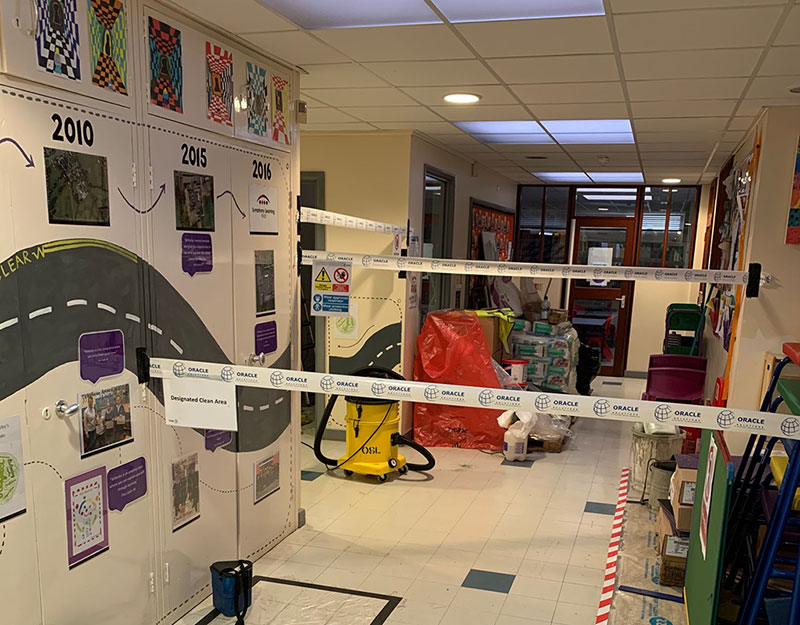If there is asbestos in a school, does it have to close?
Anyone who has ever been a parent – and therefore been anxious to ensure their children are as safe as possible when under the care or supervision of other adults – might find it quite remarkable that asbestos was once so heavily used as a building material for schools.
This was the case for much of the 20th century, especially from around the 1950s until asbestos was banned in the UK in 1999. Only towards the end of that period did the serious health risks associated with asbestos become more widely known among the general public.
Today, although asbestos is no longer used in the construction of any new school buildings in the UK, it remains present in many school premises that were built prior to the year 2000. This, in turn, necessitates careful management of any asbestos that is on site, and the risks it could pose.
The Control of Asbestos Regulations 2012, or CAR 2012, set out a “duty to manage” asbestos in non-domestic premises, including schools. But if you are the dutyholder for a given school, do you know what would constitute an “asbestos issue” necessitating the premises’ closure? And what else do you need to know about deciding whether to close, and how to manage asbestos at your school?

Where is asbestos most commonly found in schools?
In the school buildings constructed before the year 2000 in which asbestos is likely to be present, the naturally occurring fibrous mineral may be found in various products.
Examples of asbestos-containing materials (ACMs) that are commonly present in schools include:
- Asbestos lagging, as was often used on boilers and pipes as thermal insulation
- Sprayed asbestos, which saw frequent use for thermal insulation, fire protection, partitioning and ducts
- Asbestos insulating board (AIB), as was used for fire protection, thermal insulation, partitioning and ducts
- Floor tiles
- Some ceiling tiles
- Textured coatings
- Cement roofing and guttering.
What risks does asbestos pose?
Asbestos was once seen as something of a “wonder material”, due to its affordability, easy availability, effectiveness as an insulator, and fire resistance. However, over the course of the 20th century, it became widely known that the inhalation or ingestion of asbestos was perilous for human health.
The diagnosis of such frequently fatal conditions as mesothelioma, asbestosis, and asbestos-related lung cancer was linked to instances of the sufferer having been exposed to asbestos potentially many decades earlier. Since then – and the banning of asbestos altogether in 1999 – much legislation has been put in place to help guard against these risks to health.
ACMs that are in good condition and undisturbed are not believed to pose a significant risk to health, whether in schools or other types of building. However, such materials can pose a risk in the event that they are disturbed or damaged, as can happen through maintenance, repair, and/or construction work on the given site. School caretakers and contractors can therefore be at particular risk from asbestos on a school premises, due to the nature of their work.
Any disturbance that does occur to asbestos materials in a school building could cause the release of asbestos fibres, which could then be breathed in or ingested by someone nearby. Asbestos fibres being released could therefore pose a risk to the health of anyone else using the school buildings, including teachers and pupils.
Although it is unlikely that teachers and pupils will be at risk from asbestos in the course of their normal activities, this depends on any on-site asbestos being in good condition, undisturbed, and properly managed. The UK Health and Safety Executive (HSE) has also said that teachers and pupils should avoid activities that present a risk of damage to ACMs, such as pinning or tacking work to ceiling tiles or insulating board.
What does the HSE say about asbestos in schools?
As set out above, CAR 2012 puts in place certain requirements for the management of asbestos on school premises, for the person or organisation that has the “duty to manage” asbestos under this regulation.
The “dutyholder” in accordance with regulation 4 of CAR 2012, is the person or organisation with clear responsibility for the maintenance or repair of the given premises. The exact identity of the dutyholder for a school will depend on how responsibility for maintaining the site is allocated. For most schools, it is the employer that will be the dutyholder, with the employer being the local authority in the case of local authority managed schools.
Whoever or whatever the dutyholder is for a given school, they will have certain responsibilities under CAR 2012. Those duties include:
- Keeping an up-to-date record of the location and condition of ACMs on the school premises
- Assessing the risks that any on-site ACMs pose
- Putting together plans to manage the risks from ACMs in the school buildings
- Putting those plans into action
The HSE has also emphasised the importance of information about the on-site ACMs in a given school – including their location and condition – being given to anyone who could be at risk of disturbing the materials. Furthermore, the dutyholder should ensure that staff who are likely to come into contact with on-site asbestos have received suitable training.
If a school contains asbestos, should it close?
There are a few different factors that will dictate whether a school needs to close in relation to any asbestos found on-site. The HSE has stated that there may be a need for a school to close temporarily if building work on-site has resulted in unforeseen problems or perhaps led to structural damage.
If you are in any doubt about whether your school needs to close in relation to on-site asbestos, our advice on this subject would be to first get in touch with a professional asbestos consultant. Such factors as the location, type, and condition of the asbestos will largely dictate what decisions you make in relation to shutting the school.
The following principles will guide you in making the right decisions about the management of asbestos on your school premises:
- If the asbestos material is in good condition, it needs to be monitored and managed as part of an asbestos management plan
- If the material is damaged, then it should be removed
- If the material is in a part of the school that is away from general access and can be sealed off, then the school can remain open
- If the material is in a part of the school that is commonly accessed or where access is only possible through common areas, then the school will need to close – either completely or partially
- Ideally, any works on asbestos materials on your site would be carried out during the school holidays. However, any decisions that you make in this regard will be very much dictated by the risk to the health and safety of staff, pupils, and visitors.
What are the potential risks and costs of asbestos decontamination or mismanagement in schools?
There are certain important costs and trade-offs to consider when it comes to managing asbestos that might be present in your school buildings. It might not necessarily be the best decision, for example, to arrange to remove any asbestos entirely; in many cases, asbestos on a school site can be left in place, and monitored and managed over time.
However, there can also be a lot of scope for things to go wrong with the management of asbestos materials on school premises, especially in cases where dutyholders have not handled the situation properly. If you are a dutyholder for your school – and there can sometimes be multiple dutyholders – it really is crucial to ensure you are following all your obligations in accordance with CAR 2012.
You should bear in mind that in schools, there may be a high risk of certain ACMs being disturbed by everyday activities on the school premises, or accidents such as the collapse of an asbestos ceiling.
Even just one incident of asbestos disturbance on your school site could cause asbestos fibres to quickly spread across the premises. Potential examples of such disturbance incidents include if an IT cable is installed through a roof void, or if contractors do not take care to seal bags of asbestos waste.
In such situations, both the direct and indirect cost of having the wider school site decontaminated and ready to use could run into hundreds of thousands, or even millions of pounds. This is because you might, for example, need to pay for the installation of new ceilings and lighting as a result of the contamination, or even temporary accommodation for your pupils while work is carried out to decontaminate your school’s main buildings.
As you can see, then, it really can be hugely financially beneficial in the long run for your school to be proactive in its asbestos management, even if some asbestos management tasks might seem to be a chore at the time.
Final thoughts and recommendations
Ultimately, you should be in no doubt about your priority when it comes to managing asbestos on your school premises: the health and safety of everyone who uses your school buildings.
By ensuring an effective asbestos policy statement and an asbestos management plan are in place, you can help ensure you fulfil your responsibilities in relation to any ACMs on your school site. In the process, you can help make sure that – whether you do or don’t close your school due to asbestos in your school buildings – you are taking the right actions for staff and pupils alike.
Would you like to learn more about the asbestos services that could help you meet your asbestos management duties for your school premises? If so, simply call Oracle Solutions team today, or send us an email, and we will also be able to provide you with a fast and free asbestos quote.

Written by Callum McDonald
Callum McDonald is an expert in asbestos quality management, ensuring rigorous adherence to regulations and high-quality standards in removal projects. His focus on enhancing quality and client satisfaction makes him a crucial asset in safety and compliance within the field. Callum's expertise in technical support and oversight of licensed works underscores his commitment to excellence in asbestos management, providing invaluable guidance to clients in this specialised area.
